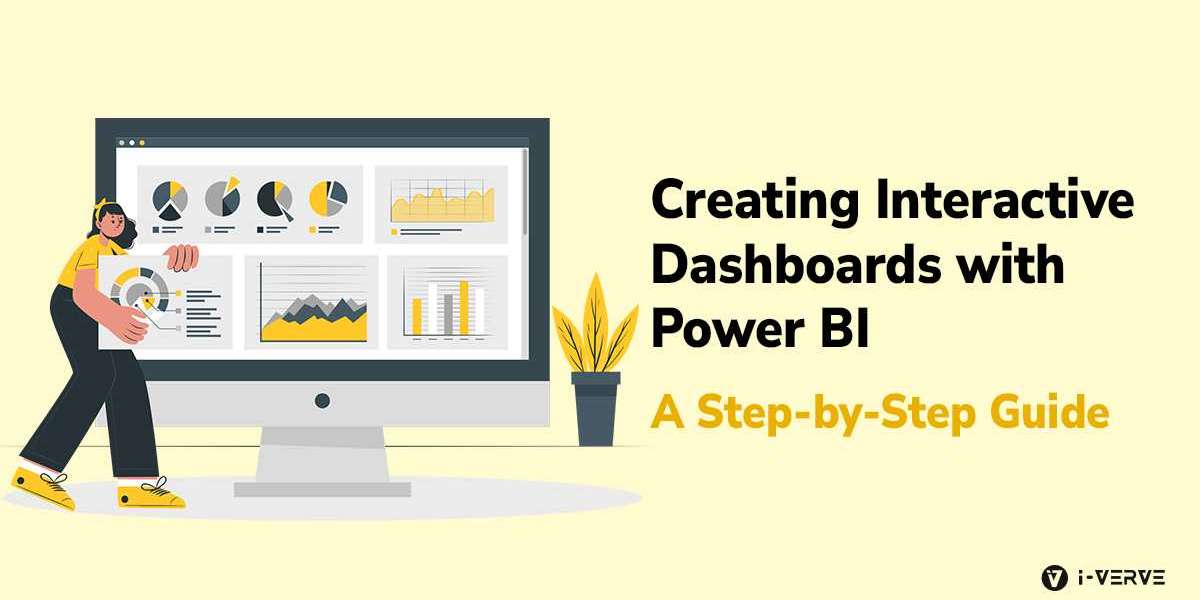Introduction
Businesses rely on insightful analytics to make informed decisions in today's data-driven world. Microsoft Power BI, a powerful business intelligence tool, enables users to transform raw data into visually appealing and interactive dashboards. In this comprehensive guide, we'll walk you through the entire process of creating interactive Power BI dashboards, from setting up your environment to advanced customization and performance optimization.
Getting Started with Power BI
Introduction to Power BI
Power BI, a pinnacle in Microsoft's repertoire, stands as a suite of business analytics tools meticulously crafted for transformative data experiences. Tailored with a user-friendly interface for end-users and robust capabilities for developers, it unfolds a dynamic fusion of interactive visualizations and potent business intelligence functionalities. Within this ecosystem, organizations are not just consumers of data; they become empowered decision-makers, gaining profound insights that drive strategic actions.
As a conduit for informed decision-making, Power BI transforms raw data into actionable insights, facilitating a deeper understanding of business dynamics. Whether you're a novice seeking intuitive visualizations or a developer diving into advanced analytics, Power BI's versatility makes it an indispensable tool for navigating the complexities of today's data-rich landscape. Embrace the introduction to Power BI as a gateway to a transformative journey in business analytics.
Setting Up Your Power BI Environment
Before diving into the world of interactive dashboards, setting up your Power BI environment is crucial. It will involve installing Power BI Desktop, the free application that allows you to create reports and dashboards. Additionally, you'll need to create a Power BI account and, if applicable, connect to your organization's Power BI service. This section will guide you through these initial steps, ensuring you're ready to harness the full potential of Power BI.
Data Preparation and Import
Gathering and Structuring Data
The pivotal step of gathering and structuring data is the bedrock for any analytics endeavor's success. In Power BI, this process is not merely a preliminary task; it's a strategic foundation laying the groundwork for meaningful insights. Furthermore, to undertake this journey, the initial focus is identifying the pertinent data sources crucial for the analysis. With its expansive capabilities, Power BI accommodates a diverse array of data sources, ranging from excel spreadsheets to databases and online services. This versatility allows users to integrate data from various origins seamlessly, consolidating information into a unified platform for analysis.
As you delve into the intricacies of gathering and structuring data, the emphasis is not solely on collection but on ensuring the cleanliness and organization of the data. Power BI provides tools and functionalities that guide users in refining and structuring data. It will ensure it is optimal for importation and subsequent analysis. This phase of the analytics process sets the stage for the transformative journey ahead, where clean and organized data becomes the fuel for insightful data-driven decision-making within the Power BI ecosystem.
Data Import in Power BI
After organizing your data, the subsequent stride involves importing it into Power BI. This process is made seamless with the tool, offering diverse sources for selection. As you import, the flexibility to perform transformations and shaping ensures further refinement of your data. This section serves as a guide through the intricacies of the data import process, guaranteeing the incorporation of accurate data essential for your comprehensive analysis within Power BI.
Building Visualizations
Introduction to Visualizations
At the core of every Power BI report or dashboard lies the essence of visualizations, transcending raw data into profound insights. Additionally, it ensures a nuanced understanding of when and how to choose the right visualization for your specific dataset. Recognizing the pivotal role visualizations play, delve into the rich library of charts, graphs, and maps within Power BI.
Creating Visualizations in Power BI
Transition theory into action as you delve into the creation of compelling visualizations within Power BI. Master the art of crafting impactful visuals using the tool's intuitive drag-and-drop functionality and customization options. This section serves as your guide through the basics of visual construction, unveiling techniques to enhance their overall impact. From foundational principles to advanced customization, empower your data narratives by transforming them into visually compelling stories within the versatile canvas of Power BI.
Designing Interactive Dashboards
Dashboard Components
Power BI dashboards amalgamate visuals and reports, presenting a consolidated snapshot of your data landscape. Navigate through the integral components of a Power BI dashboard, deciphering the significance of tiles, visuals, and slicers. Mastery of these elements is pivotal, equipping you with the knowledge to craft not only visually appealing but also functionally sound dashboards.
Building Interactive Dashboards
Unlock the full potential of Power BI by mastering the art of building interactive dashboards. This section guides you to infuse life into your dashboards through features like drilldowns, cross-filtering, and other interactive elements. Beyond the aesthetics, interactive dashboards create an immersive and insightful user experience. Learn to captivate your audience with visually impressive and dynamically engaging dashboards, making data exploration not just a process but a journey of discovery within the versatile landscape of Power BI.
Data Interactivity and Insights
Adding Interactivity to Data
In the Power BI realm, interactivity is the linchpin to unlocking the true potential concealed within your data. This section embarks on an exploration of features designed to infuse dynamism into your analysis. From establishing relationships between data tables to leveraging slicers for targeted filtering and creating dynamic measures, every facet contributes to making your data responsive to user inputs. Consequently, the result is a vibrant and user-friendly experience where data speaks and actively engages with the user's exploration.
Extracting Insights from Dashboards
After building upon the foundation of interactivity, this section delves into the extracting actionable insights from your Power BI dashboards. Uncover the art of identifying trends, outliers, and patterns within your data – turning raw information into a narrative of business intelligence. Whether employing natural language queries for a user-friendly approach or delving into advanced analytics functions, discover how to elevate your interactive dashboards into invaluable sources of information. This phase marks the culmination of interactivity, where the true essence of Power BI emerges – transforming data exploration into a strategic asset for decision-makers. Subsequently, through these insights, Power BI becomes a tool and a conduit for informed and empowered decision-making within the ever-evolving data analytics landscape.
Sharing and Collaboration
Sharing Your Interactive Dashboards
Leveraging Power BI's collaborative features, this section facilitates seamless sharing of insights. Navigate the process of transferring your interactive dashboards to colleagues and stakeholders, exploring diverse sharing options. From exporting reports to the simplicity of publishing on the Power BI service, ensure your valuable insights effortlessly reach the intended audience. Consequently, this process will automatically foster a collaborative environment for informed decision-making.
Collaboration Features
More than an individual tool, Power BI emerges as a collaborative platform. Delve into features like co-authoring, commenting, and version history, amplifying collaboration within your team. Furthermore, uncover how Power BI cultivates a collaborative environment, facilitating shared insights, constructive discussions, and collective refinement for a harmonized approach to data analysis and decision-making.
Advanced Techniques and Tips
Advanced Customizations
As your proficiency in Power BI grows, the allure of advanced customizations becomes irresistible. This section is a gateway to elevating your reports and dashboards to unparalleled heights. Delve into sophisticated techniques, seamlessly transitioning to the art of crafting custom visuals. Additionally, explore the powerful realm of DAX (Data Analysis Expressions) formulas for intricate calculations. The exploration of these advanced customizations is not merely an enhancement but a manifestation of your evolving mastery over Power BI. It will transform it into a tool that harmonizes with your business's unique identity and requirements.
Performance Optimization
In the dynamic landscape of data analytics, optimizing the performance of your Power BI reports is paramount for ensuring a seamless user experience. This section unfolds a comprehensive guide to enhancing the performance of your Power BI solutions. With these insights, your reports will load swiftly and operate unparalleled. Consequently, this will create a user experience that is informative but also agile and responsive. In pursuing data-driven excellence, performance optimization becomes the keystone, ensuring that Power BI is not just a tool but a finely tuned engine driving insightful decision-making within your organization.
Conclusion
In conclusion, creating interactive dashboards with Power BI is a journey that begins with setting up your environment and progresses through data preparation, visualization, and advanced techniques. Power BI empowers you to not only analyze data but also to share insights collaboratively. As you continue to explore and apply the principles outlined in this guide, you'll create impactful dashboards that drive informed decision-making within your organization. Moreover, explore the transformative capabilities of our Power BI development services, from uncovering hidden patterns to predicting trends. It will Empower organizations to harness the true potential of their data. Our services pave the way for data-driven excellence and informed decision-making.



